Comic artist, publisher and writer Bambos Georgiou takes a look at just some of the European comic strips that once featured in Fleetway’s British weekly comics, supplementing originated strips….
The UK comics industry in the 1960s has often been cited as one of the largest in the world, leading to a voracious appetite for material. Many smaller publishers licensed American comic strips after World War Two, with L. Miller & Sons reprinting Captain Marvel characters. The larger companies like DC Thomson and Amalgamated Press, which would become Fleetway (and, eventually, IPC), mainly used UK artists, but the comic market was booming and comics were often the last resort of a commercial artist who would much rather have worked in the more lucrative field of advertising. This would change in the later 1950s with an influx of artists from abroad helped feed the high demand for comic strips at both Fleetway and DC Thomson, often with breathtaking results.
The first instance of Fleetway reprinting a European strip that I can find, using Steve Holland and Dave Ashford’s Collector’s Guides as reference, is in The Sun (which was a comic back then rather than a newspaper), which in November 1950 ran “The Jester’s Revenge“. Unfortunately there are no credits for this strip or for “Hal Hotspur” which appeared in February 1951 and was also a European strip.
Both stories have medieval themes and were cut and paste jobs often appearing in the centre pages and on the back cover with distinctive flat colouring of the time. The Sun and its companion comic The Comet would often turn the black line to blue and then colour the strips, creating a rather odd effect. Other pages would be two colour while the balance was printed in black and white.
“The Phantom Knight” reprinted in The Comet from February 1955 followed the pattern set by The Sun. This medieval strip had three pages all in the distinctive colours just described. Researchers will have to rely on stumbling across the source material of these strips to assign creative credits and original titles, or it may be revealed that they are actually original works by obscure un-named artists.
The first European reprint that can be credited is “The Adventures of Boy Colin“, which appeared in The Sun in October 1954. This was originally Les Extraordinaires Aventures de Corentin by Belgian creators J Van Melkebeke and Paul Cuvelier and The Sun ran two pages a week for a whole year. This means the first two Corentin albums at least were translated into English.
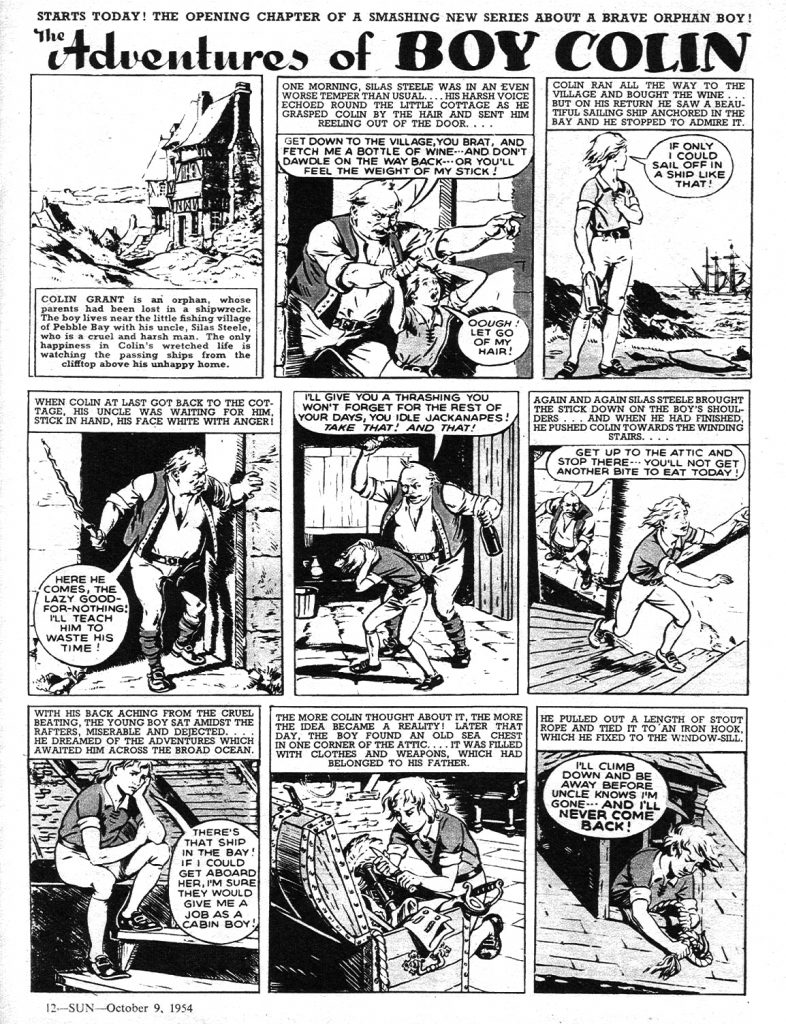
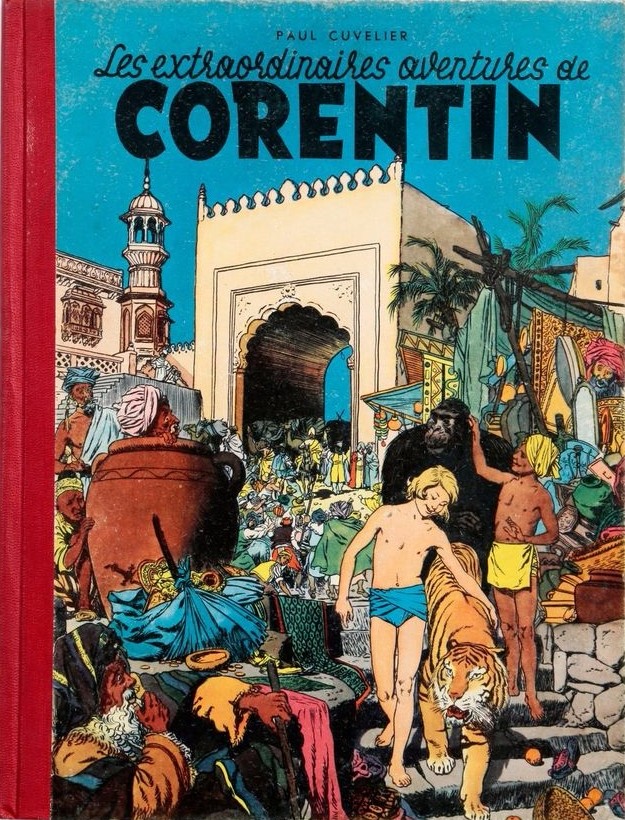
Also in 1954, Super Detective Library adapted Les Pionniers de L’Esperance by the French team of Raymond Poivet and Roger Lecureaux. The strip is generally cited as the first major French science fiction strip and was remodelled as the adventures of “Paul Darrow“, who was cast as a science fiction detective. Over the course of two years six “Paul Darrow” strips appeared in Super Detective Library, interspersed amongst editions featuring “The Saint”, “The Toff” and “Sherlock Holmes”.
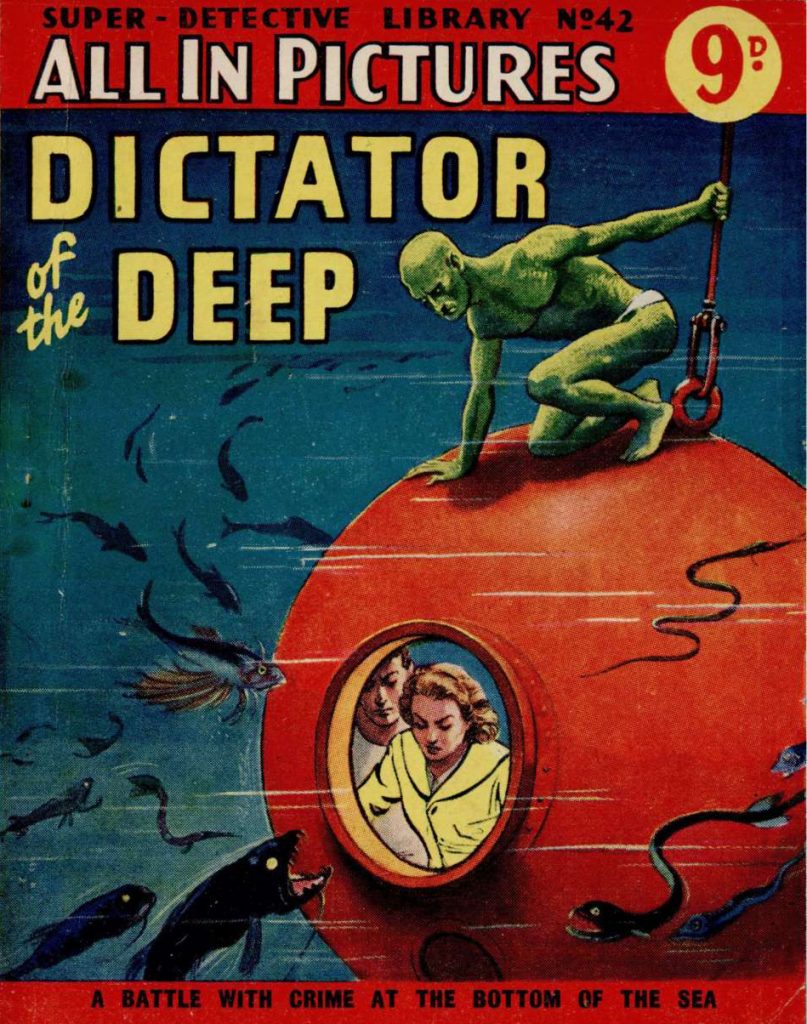

Only about one in four Super Detective issues contained commissioned material, with the title often using newspaper strips, both British and American to fill its pages. This practice would last through the comics’ entire run, with “Rip Kirby” and “Buck Ryan” appearing in later issues alongside commissioned strips featuring Blackshirt, John Steel and Rick Random, who continued the science fiction angle.
The next appearance of European reprints popped up in Knockout in 1960, when Jerry Spring by Jije was transformed into “He’s Slade“, beginning in April. Hot on one European legend’s heels was another, Hugo Pratt‘s Anna of the Jungle debuted in Knockout in May 1960, titled “Jungle Drums“. For many of these strips their Fleetway appearances mark the only time they have been translated into English, Pratt’s strip is edited down from its original length and is generally chopped about mercilessly, a fate that befell many of the strips.

Next up was “Paladin the Fearless” in the first issue of Valiant, by Jean Michel-Charlier & Albert Uderzo, a reprint of Belloy which appeared in Pilote. Charlier & Uderzo would also provide the raw material for “Little Fred and Big Ed“, the first British reprint of Asterix the Gaul, which was followed in Ranger, in 1965, with a reprint of Asterix and the Big Fight which was published as “Britons Never, Never, Never Shall be Slaves“.
In both these early English versions of Asterix, the setting was changed to make the heroes ancient Britons rather than Gauls. In “Little Fred and Big Ed”, Asterix was a Briton called Little Fred: the Ancient Brit with bags of Grit, his sidekick Obelix was called big Ed and Getafix the village druid was called Hocus Pocus.

For “Britons Never, Never, Never Shall be Slaves” in Ranger, Asterix was renamed Beric, Obelix was called Son of Boadicea and his dog, Idéfix, was called Fido. While the storyline of “Little Fred and Big Ed” was similar to Asterix the Gaul, sometimes John Sanders English text for “Britons” was pretty different compared with both the original French edition of Big Fight.
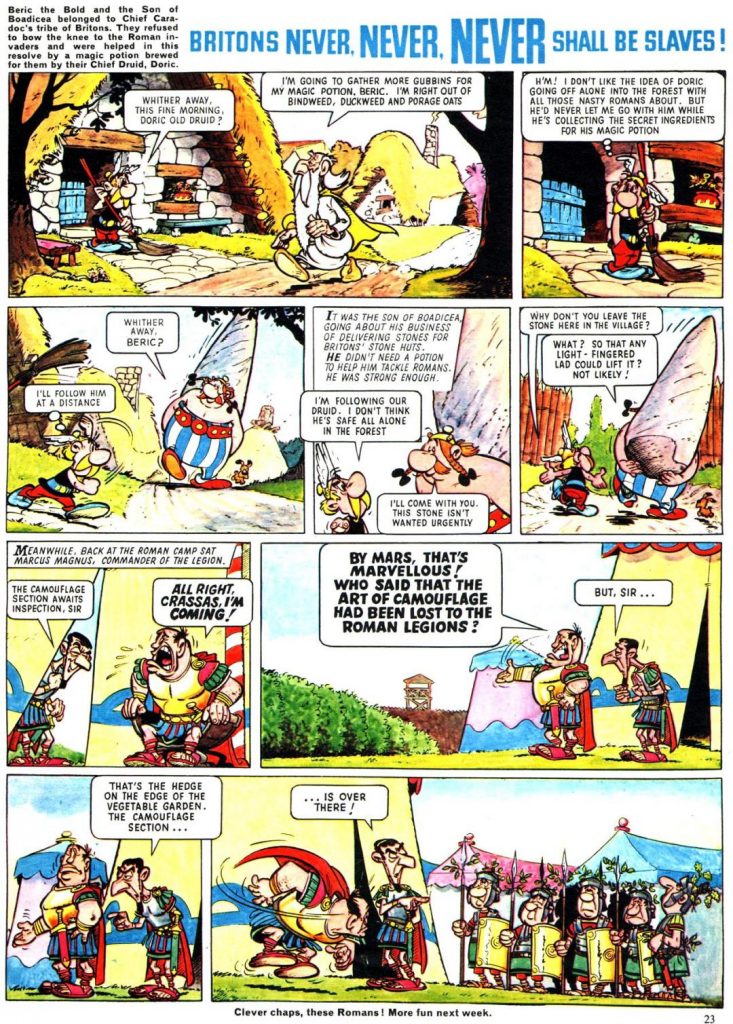
“Britons Never, Never, Never Shall be Slaves” was followed by a reprint of Asterix and Cleopatra when Ranger ceased publication in June 1966 and was incorporated into Look and Learn, serialised as “In the Days of Good Queen Cleo“.
As in “Britons Never, Never, Never Shall be Slaves”, the artwork for “Cleo” was the same but The Book Palace notes the wording was totally different, including Obelix’s name being changed from Son of Boadicea to Doric. All three stories were translated by Sanders, who would go on to become the company’s editorial director.
Charlier and Uderzo’s Tanguy & Laverdure also appeared in the UK, published as “The Flying Furies” in Lion in 1966 (the only European reprint to appear in Lion) Their British incarnation is detailed here on downthetubes.
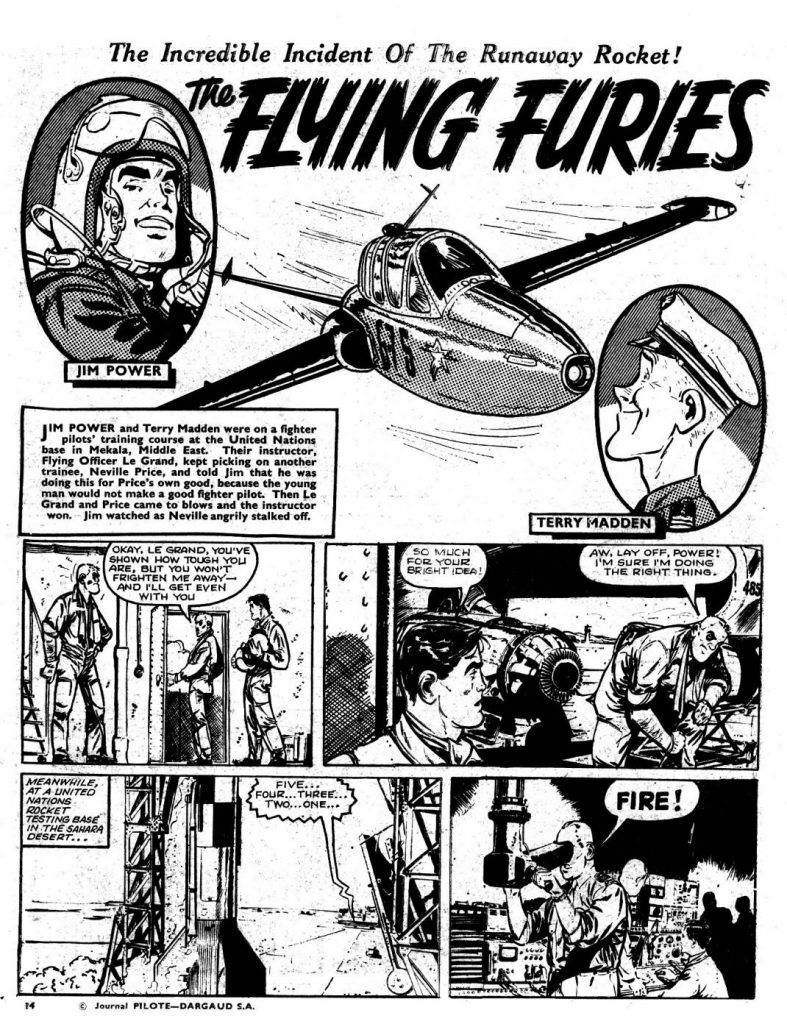
Both Tanguy and Laverdure and Asterix were phenomenally successful on the continent, but only Asterix found lasting popularity in the UK in book form, alongside Tintin. (Tintin’s first English appearance was in another comic, of course – a reprint of King Ottokar’s Sceptre, which ran in Hulton Publications Eagle, in 1953).
The Asterix collections we all know today were initially published by Brockhampton Press from 1969 onwards, mostly translated by Anthea Bell and Derek Hockridge.
Valiant would go on to reprint European strips in 1965 when Charlier & Giraud’s “Fort Navajo” featuring Lieutenant Blueberry got its first English translation. The strip was actually called “Fort Navajo” in Valiant.
The 1965 to 1967 period would see the largest number of translations from Fleetway, with Buster, Valiant, Lion, Ranger, Champion and Giggle all featuring European strips.
Buster ran “Bob Morane & The Crystal Towers“, a translation of one of the many Bob Morane albums. Morane has also been the subject of paperbacks (one of which was published in the UK) and a tv series in France. “Old Nick“, a one page humorous pirate strip also appeared in Buster from May 1966, very much in the Asterix mould, but no creator credits exist as yet.
Also in 1965 Valiant featured a series of science fiction strips that look suspiciously like Spanish comics which appeared in landscape editions such as Mundo Futuro. Valiant also translated Juan Roba’s Boule et Bill for the first time, calling it “It’s A Dog’s Life“, which is currently available through Cinebook as Bill & Buddy, (giving the dog’s name to the boy…)
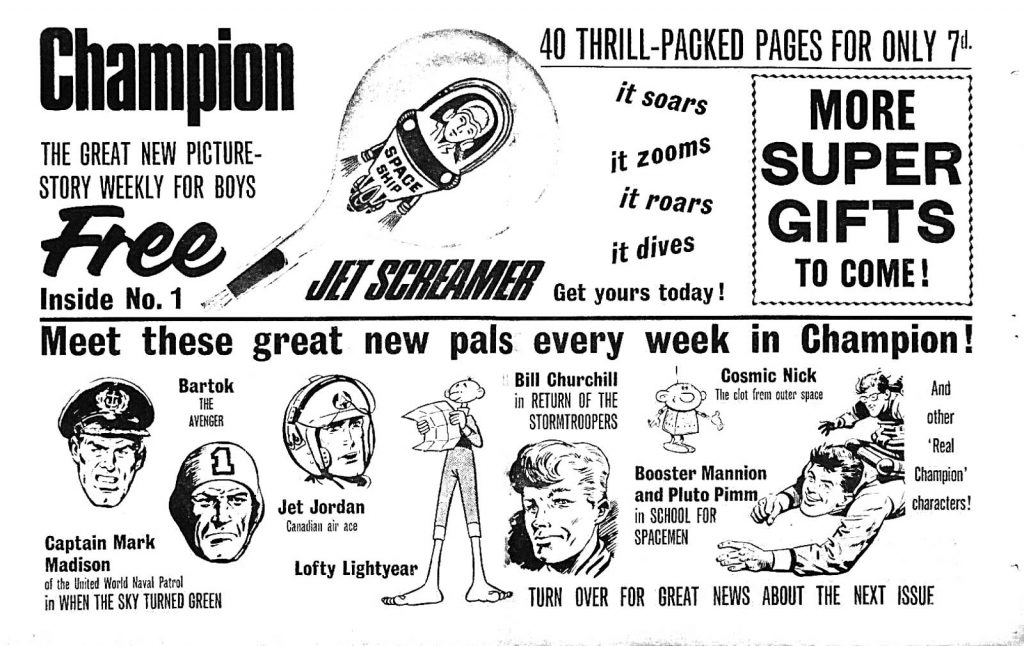
1966 saw the launch of Champion, which was crammed full of European translations. “Jet Jordan” was actually Dan Cooper by Albert Weinberg, “Knights of Konigsfield” was Michel Vaillant by Jean Graton, “Boy Kidd” was Lucky Luke by Morris & Goscinny, “Jinks” was Modeste & Pompon by Franquin and “Whacker” was Starter by Jidiehem. There was also “Hunters without Guns“, another as yet unidentified European strip, and “Space Travellers“, which may also be reprint. The balance of Champion was filled with one or two new strips and reprints of British strips, and a number of the Champion series carried on in Lion, when the two titles merged.
Giggle, a predominantly humour comic launched in 1967, had a large amount of European material, with Lucky Luke making yet another appearance this time under the title of “Buck Bingo“, and “Herlock Sholmes” by Julio Radilovic appeared with name intact. “Captain Swoop” is credited as being a European strip but of unknown origin and “Tammy Tuff” is actually Benoit Bricefer, by the Smurfs’ creator Peyo.
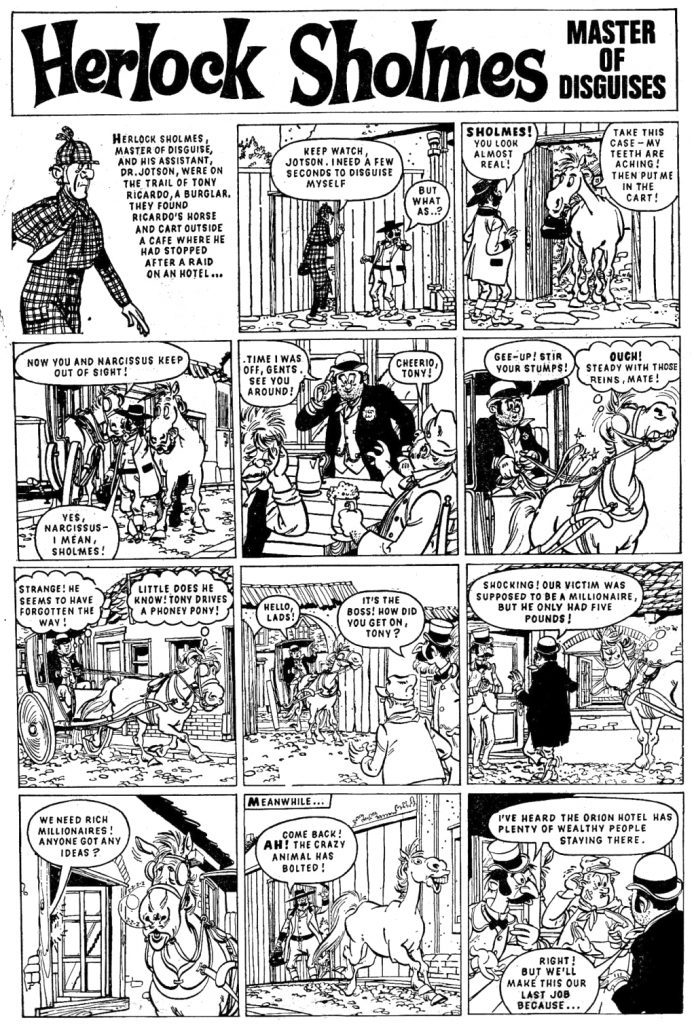
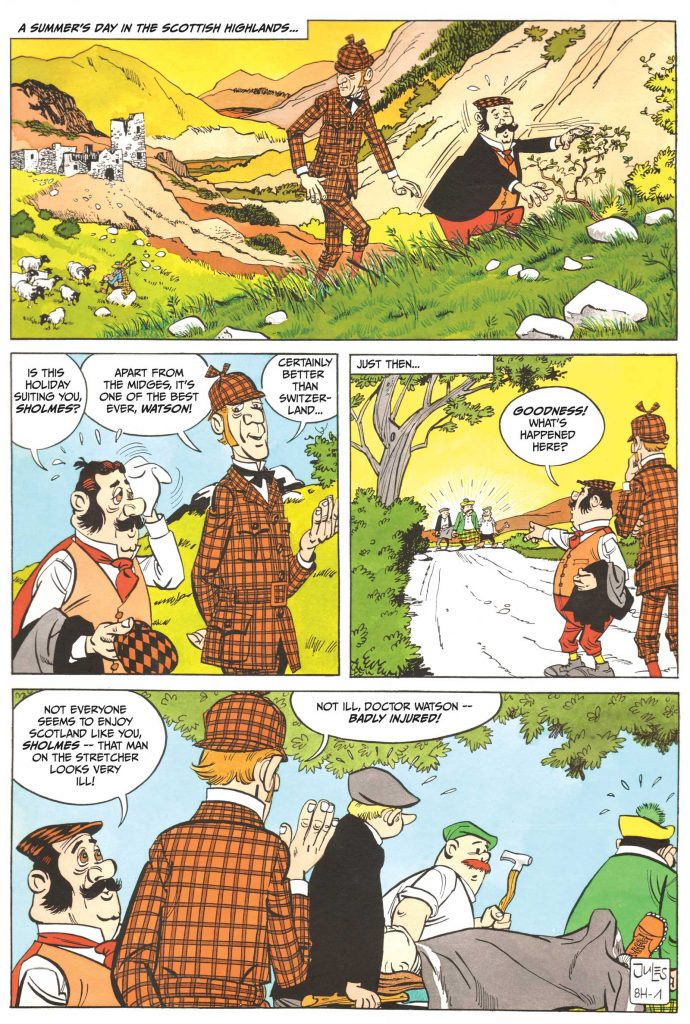
There is also a Western adventure strip called “The Brave Ones“, which looks like the work of Carlos Roume and could be a translation of his strip Brave Eagle. It’s unclear whether “Dim Dan” was a European reprint or drawn by a probably Spanish artist. Chances are, it’s the latter, as Reg Parlett continued the strip and Fleetway never continued any reprinted strips with new artists.
Both Champion and Giggle swiftly merged with other titles in efforts to boost their circulation, a practice dubbed “Hatch, Match & Dispatch” by Pat Mills. New comics benefitted from high circulation because they were launched with expensive TV advertising campaigns. Fleetway started to abuse those early sales figures by cancelling the new comic and merging it with a longer running comic to boost its sales.
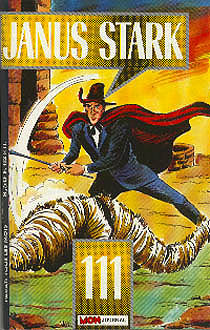
By 1967, Fleetway had stopped translating European strips, which even though they were of a high quality and the right genres lacked the peculiarly off-beat gimmick which most British strips needed to be a big hit in the weekly comics. Fleetway’s use of foreign material from Europe and sometimes America paints a picture of a thriving industry hungry for content.
Indeed, as noted many times on downthetubes, many Fleetway characters such as The Spider, Janus Stark, Robot Archie, The Steel Claw and the strip “The Rise and Fall of the Trigan Empire” found great success in European and South American editions. New material featuring Janus Stark and Robot Archie was even produced in France and Holland respectively, where the characters enjoyed huge popularity. The French market even lured away Don Lawrence to work for them in their far more rewarding comic industry.
Sadly, while the European creators would have been paid a royalty when Fleetway reprinted their work. unfortunately artists working for Fleetway didn’t benefit in the same way when their work was reprinted abroad.
This article hopefully gives you a guide to just how many European strips appeared in Fleetway’s British comics in the 1950s and 60s. There are, I’m sure, others, as yet unidentified – and I haven’t even covered European strips re-published in annuals here!
Bambos Georgiou
Bambos Georgiou was the co-founder of Acme Press in the 1980s and Aces Weekly in the teens, with stints as writer, artist, letterer and editor at various companies in the UK and USA in between. His most recent work; inker on Lion Kids’ Bible and Anno Dracula and writer on Slash Moron graphic novel, currently available on Indiegogo
WEB LINKS
• Read our Janus Stark Profile, which includes information on the character’s overseas adventures
• Robot Archie’s adventures in Holland
• BD Gest is a terrific resource for French comic titles
• Buy Asterix books from AmazonUK (Affiliate Link by most recent release)
With thanks to Martin Crookall for additional information
One of many guest posts for downthetubes.
Categories: downthetubes Comics News, downthetubes News
 FML, new creator-owned series from Kelly Sue DeConnick and David López, promoted with ingenious guerrilla marketing
FML, new creator-owned series from Kelly Sue DeConnick and David López, promoted with ingenious guerrilla marketing  Dark Horse, Hasbro, tease new Dungeons & Dragons, Magic: The Gathering projects
Dark Horse, Hasbro, tease new Dungeons & Dragons, Magic: The Gathering projects  The SEQUENT’ULL Interviews: Dan White
The SEQUENT’ULL Interviews: Dan White  Sports comic highlights an immortal rugby match
Sports comic highlights an immortal rugby match
Tanguy & Laverdure also took flight as The Aeronauts. The Beeb broadcast the tv show under that name and World Distributors published the inevitable annual.
Thanks, Simon – we have a fuller article on Tanguy & Laverdue‘s British incarnation as The Aeronauts” here on downthetubes. It’s a fantastic strip.
One correction. It was Lion that absorbed Champion, not Valiant. I know that as I was reading Lion at the time, and still have one of my old comics that shows the title as Lion and Champion.
Thanks John – fixed. Glad you enjoyed Bambos’s feature